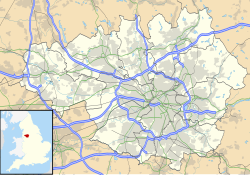Top Qs
Timeline
Chat
Perspective
Glodwick
Human settlement in England From Wikipedia, the free encyclopedia
Remove ads
Glodwick is an area of Oldham, Greater Manchester, England. It is south-east of Oldham town centre.
Glodwick is a multi-ethnic residential area in the south of Oldham, home particularly to a large community of Pakistanis and British Pakistanis.
Glodwick is marked architecturally by Oldham's history with the Industrial Revolution, particularly cotton spinning. Much of Glodwick's housing remain as red-brick terraces, built originally as dwellings for Oldham's many cotton mill workers.
Remove ads
History
Summarize
Perspective
Etymology
The name Glodwick was recorded first as Glodic in the 1190s.[1] The first element may be a Brittonic word related to Welsh clawdd, meaning "ditch, hedge".[1] Gloddaeth in Wales may have a similar etymology.[1] The second part of the name is harder to explain,[1] but may be the Old English dic, likewise meaning "ditch", added later to the Brittonic word.[1]
Medieval history
Lying within the historic county boundaries of Lancashire since the early 12th century, Glodwick, one of the oldest parts of Oldham, was recorded in 1212 as being one of five parts of the thegnage estate of Kaskenmoor, which was held on behalf of King John by Roger de Montbegon and William de Nevill.[2][3] The other parts of this estate were Crompton, Oldham, Sholver and Werneth.[4] Glodwick later formed part of the township of Oldham within the ancient ecclesiastical parish of Prestwich-cum-Oldham, in the hundred of Salford.[3]
Industrial revolution
In the late-19th and early-20th centuries, Glodwick provided a base for many of the cotton mills that made Oldham the most productive mill town in the world. Spinning companies like Samuel Milne, Lees & Wrigley, James Collinge & Sons and Bagley & Wright brought employment to the area.[5]
Riots
In May 2001, Glodwick was the centre of controversy as it was at the heart of the Oldham Riots - large scale rioting said to be fuelled by long-term under-lying racial tensions between local white and South Asian communities. The rioting gained international media coverage, and were said to be the worst racially-motivated riots in the United Kingdom for fifteen years prior, briefly eclipsing the sectarian violence seen in Northern Ireland.[6]
Remove ads
Landmarks

One of Glodwick's best-known features is Alexandra Park.
Greengate Street Mosque is Oldham's largest mosque.[citation needed]
St Mark's Church stands on the hill above Oldham at Glodwick. It is the parish church for the area.
Lowside Brickworks
Close to Glodwick is a disused quarry that has been designated as a Site of special scientific interest (SSSI) known as Lowside Brickworks. The site is only 3.5 acres (1.4 hectares) but has considerable geological interest. It has yielded bivalves from the Carboniferous period showing how they interacted with the sediment, which also helps understanding of their morphological variation. Lowside Brickworks is one of 21 SSSIs in the Greater Manchester area.[7][8]
Remove ads
Second World War
On 24 December 1944, at 5.50am, a V-1 flying bomb fell on Abbey Hills Road near to the junction with Warren Lane. The explosion killed 32 people and destroyed a large number of houses. The bomb was one of over thirty released that morning by a large formation of German Heinkel He 111 bombers just off the North East coast of England.[9]
Transport
Bee Network operate the following services in Glodwck
425 service runs through Glodwick to Holts Estate via Abbeyhills and to Fitton Hill via Oldham.
There is no railway station nearby, Glodwick Road station having closed in 1955, but there is a nearby Metrolink stop, which is Oldham Mumps, currently providing links to Manchester and Chorlton.
Notable people
- William Joyce, was a short-term resident of Glodwick.[10]
- Joseph Lees (1748–1824) - regional dialect poet from Glodwick, who wrote Jone o Grinfilt.[11] He was a hand-loom weaver and schoolteacher accustomed to "study on his seatboard, and when he had thrown a few ideas into rhyme he stopt picking-o'er and wrote it down".[12]
References
Wikiwand - on
Seamless Wikipedia browsing. On steroids.
Remove ads
